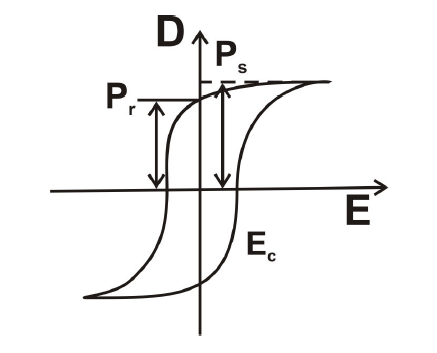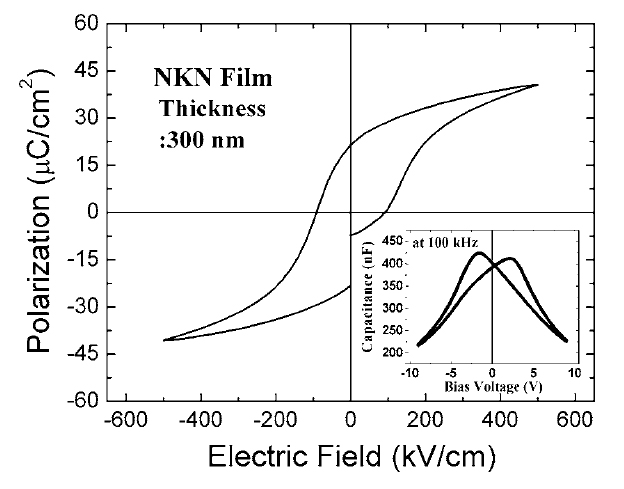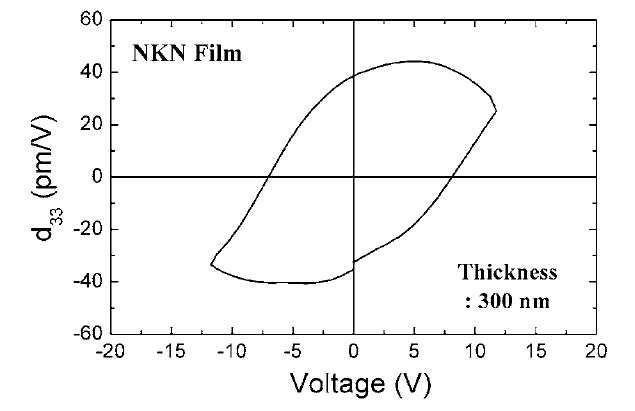Ferroelectric and Piezoelectric Proberties of NKN
A primary feature distinguishing ferroelectrics from other pyroelectrics is that the
spontaneous polarization can be reversed with an applied electric field. Threfore it is beneficial
to take a closer look at ferroelectric hysteress loop.
A typical
hysteresis loop is shown in the figure below. At low fields well below the coercive field Ec and
at high fields above Ec a ferroelectric behaves like an ordinary
dielectric but at Ec polarization reversal occurs giving a large
dielectric non-linearity. The area within a loop is a measure of the energy required to
twice reverse the polarization. At zero electric field the electric displacement within a
single domain can have two values corresponding to the opposite orientations of the
spontaneous polarization. In a multi-domain crystal the average electric displacement at
zero field can have any value between these two extremes. In principle the spontaneous
polarization is equal to the saturation value of the electric displacement extrapolated to
zero field.

The remanant polarization Pr (the displacement at zero field)
may be different from spontaneous polarization Ps if reverse nucleation occurs
before the applied field reverses. This can happen in the presence of internal (or
external) stress or if the free charges below the surfaces cannot reach their equilibrium
distribution during each half-cycle of the loop. Additionally, if the material is constraint
the saturated polarization may not be achieved.
The defects such as impurities affect the dielectric properties and the switching
behavior. The defects in any crystalline lattice generally cause deformation of the
surrounding volume and modification of the local fields. The defects induce an
additional term of polarization. When the polarization of a crystal is reversed by an
applied field, the difference in polarization between the perfect crystal and real crystals,
latter one including the defects, does not necessarily need to reverse. If it does reverse
then the coercive field will depend on both the field required to switch the defects and
the sign and magnitude of the polarization difference. In general the presence of defects
tends to increase the coercive field. If the polarization does not reverse in an external
field the defects can have a marked effect on the switching properties depending on the
distribution of the polarization difference throughout the crystal volume. If all the defect
dipoles have same direction the hysteresis loop will appear biased, e.g. shifted along the
axis of electric field [1].
The next figure is a a hysteresis loop which was observed in Na0.52K0.48NbO3.
The P-E hysteresis loop was well saturated. At an applied field of 500 kV/cm, the remnant polarization
(Pr) and the coercive field (Ec) are 22.5 µC/cm2 and 90 kV/cm, respectively.
The ferroelectric P-E hysteresis loop remained at the higher field above 500 kV/cm. This may be due to the
low accumulation of charge carriers such as O, Na, and K vacancies.

The inset the figure shows the capacitance versus voltage (C-V) curve for NKN film annealed at 700 °C.
The C-V curve displayed a butterfly shape at room temperature. Peaks were observed at 1.6 and 2.2 V,
corresponding to positive and negative coercive fields, respectively. Thus, the ferroelectricity
of NKN film is confirmed.
Remarkably, although the NKN film was exposed to ambient air for a long time (3 years), there was no change
in its physical properties due to humidity. When the NKN film was subjected to
1*1010 read/write cycles at a frequency of 1 MHz, the film did not exhibit any change in
polarization fatigue of the P-E hysteresis loop [2]. Thus, the NKN films have stable ferroelectric
properties comparable to PZT.
The last figure shows the piezoelectric d33 response with an applied voltage for the NKN thin
film with a thickness of 300 nm. The piezoelectric response signal was calibrated by using x-cut quartz
single crystal [3]. The piezoelectric hysteresis loop was obtained for an applied voltage of -12 to
+12 V on an area of 2x2 µm2. The d33 hysteresis loop was observed and the piezoelectric
constant was estimated to be 45 pm/V.

Shibata et al. [4] reported the relative transverse piezoelectric
coefficient e31=d31 / s11=-5.5 C/m2 for the NKN films on Pt/Ti/SiO2 / Si substrates.
The piezoelectric constant d33 of polycrystalline PbZr0.45Ti0.55O3 thin
film and epitaxial PbZr0.30Ti0.70O3 thin film, grown by pulsed
laser deposition, are about 10 and 40 pm/V, respectively [2]
Thus, a piezoelectric constant for NKN film of 45 pm/V is comparable to that of PZT film.
Therefore, NKN thin film is a good candidate material for lead-free piezoelectric thin film.
References:
- M.E. Lines and A.M. Glass: Principles and applications of ferroreletrics and related materials,
Edited by: W. Marshall and D.H. Wilkinson, The international Series of Monographs on Physics, Clarendon Press,
Oxford, 1979
- J. S. Lee, H. J. Lee, J. Y. Lee, S. H. Kang, I. W. Kim, C. W. Ahn, and G.
S. Chung, J. Korean Phys. Soc. 52, 1109 (2008)
- J. S. Kim, I. R. Hwang, S. H. Hong, J. H. Lee, B. H. Park, A. C. Woo, and
N. Sahn, J. Korean Phys. Soc. 48, 1583 �2006�
- K. Shibata, F. Oka, A. Ohishi, T. Mishima, and I. Kanno, Appl. Phys.
Express 1, 011501 (2008)





